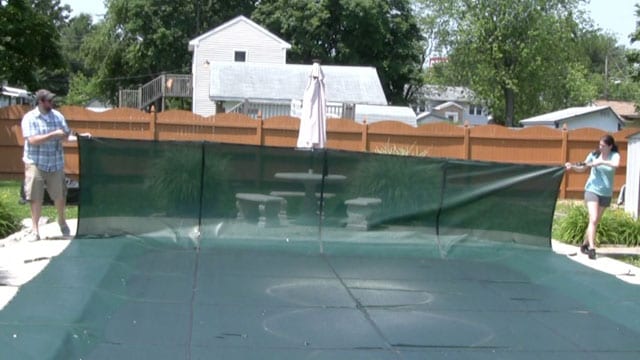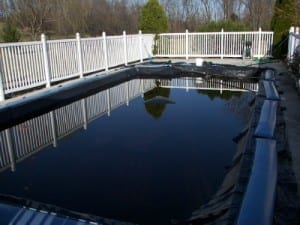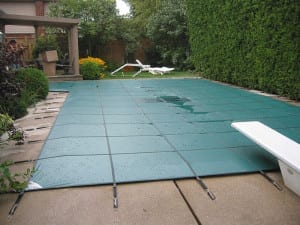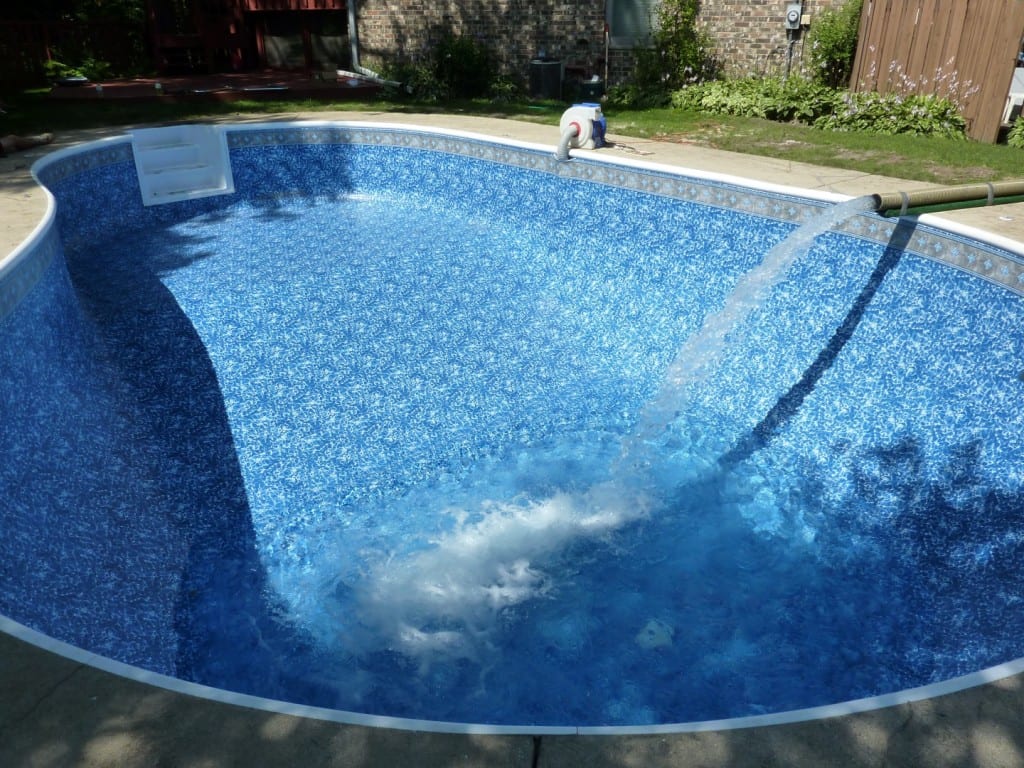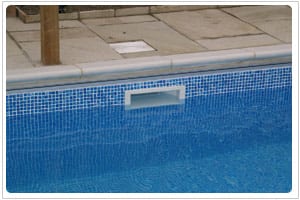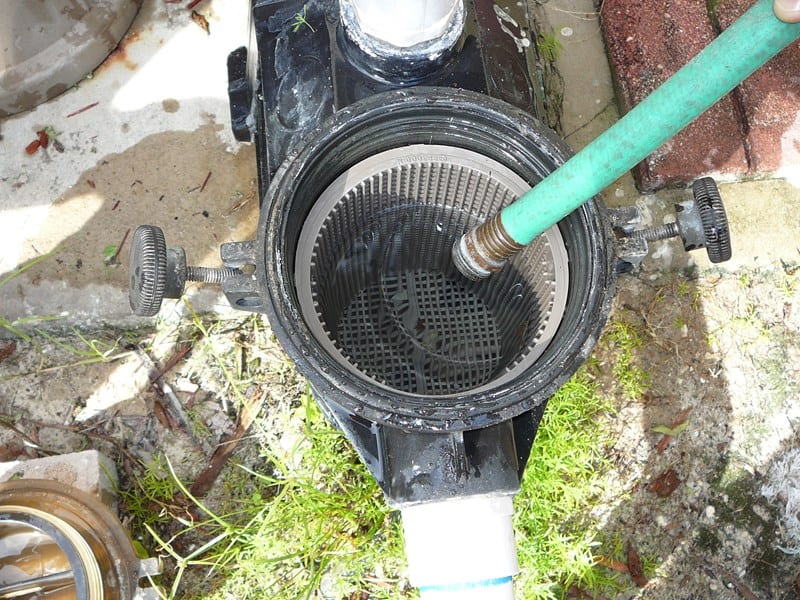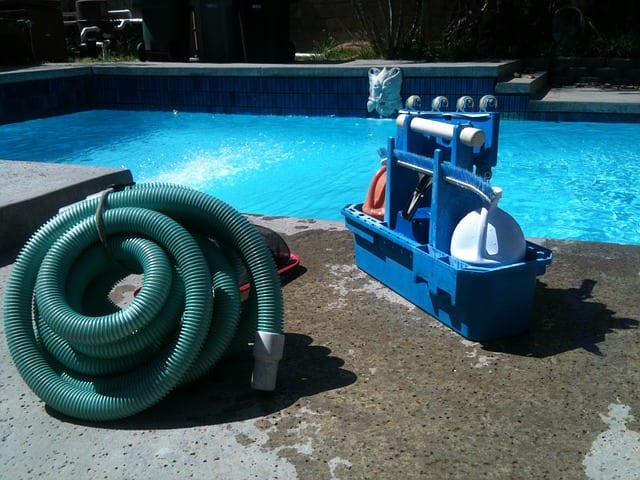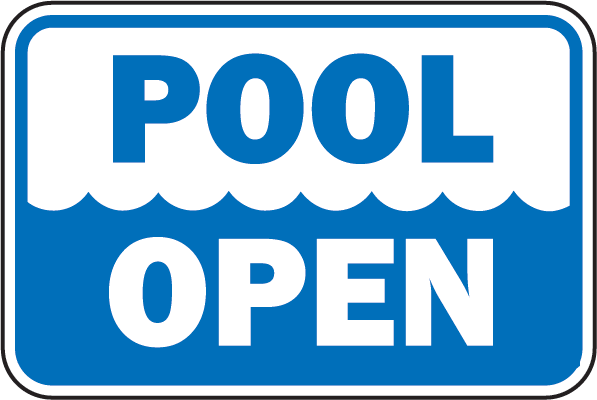Trying to figure out how to open your swimming pool?
This guide is for you
Maybe it’s your first-time opening your pool, or maybe you normally hire a swimming pool service. Either way, this post exists to walk you through the process step by step. But, keep in mind that opening a pool takes a good amount of time, so pick a day to get an early start.
From lifting up your pool cover to cleaning out the water and making it crystal clear again, we go over everything.
Ready to get started?
Open Your Swimming Pool: Phase 1
Removing the pool cover
Drain it
Removing your pool cover is simple, but requires a little teamwork. Before loosening, unraveling, or unscrewing anything, grab a siphon or submersible pump and drain as much water as possible from the surface of the cover. Doing so makes it easier to quickly remove and fold up your cover later.
Sweep it
From there, it’s time to pick up a broom and do a little housekeeping. Walk around the deck and sweep away all the leaves, sticks and debris (you don’t want them getting into your freshly opened pool).
Repeat this step for the surface of the cover as well. Use a leaf blower or extendable pole to reach any stubborn leaves stuck in the center.
Remove it
Water Bag Pool Cover
With water bag pool covers, it’s especially important to drain all water from the surface of the cover before removal. Mainly because not doing so puts unnecessary strain and wear on the pool cover, reducing its lifespan.
So once you pump all the water out of the cover, remove the water bags and gently place them in a safe area for draining. Next, pop/unscrew the top off of the bags and let all the water flow out.
When the bags are fully drained, set them aside for cleaning and brushing.
Removing the cover
Starting at the deep end, team up with a friend and grab opposite ends of the cover.
With each of you holding a corner of the cover, fold it over as you walk to the other end of the pool. The corners of the cover you grabbed should overlap with the corners of the shallow end once it’s folded.
From there, walk back to the middle of the pool, grab the folded end of the cover, and repeat.
When finished, lay the cover out on a flat area and unwrap it for cleaning. A simple pool brush and bucket of soapy water should do the trick.
Allow the cover to dry completely, then fold it up for safe storage.
Safety Pool Covers
With the cover drained and cleaned off, walk around the pool and start removing the cover anchors.
Manually lift and twist the springs out, or use a cover rod (typically included with the cover) to streamline the process. Once you remove all the springs, take a 1/4 hex wrench/key and twist the brass anchors down into the deck.
Next, gradually fan-fold the cover from one end of the pool to the other. When you reach the other end, grab the cover and fold it onto itself twice. Then, pick up the cover and drape it over a chair or fence, allowing it to dry.
Once dry, safely store the cover indoors
Restoring the water level
Time to fill up your swimming pool.grab the garden hose and hang it over the edge
Start by grabbing the garden hose and hanging it over the edge of the deep end.
Fill the pool a few inches past mid-skimmer level. The extra water is needed for what comes next.
Fun fact: during the time a pool is closed, a good portion of water evaporates, hence why you’re replacing it.
Putting the pool back together
This part of the process is all about removing unnecessary equipment and reinstalling essentials.
Here’s a simple checklist to help you open your swimming pool:
Around the pool
- If you used any pool anti-freeze during the winterizing process, flush it out of the system.
***IMPORTANT: Do not remove any plugs until anti-freeze is completely flushed out - Replace the skimmer baskets and return jet eyeball fittings
- Remove any plugs remaining in the lines, wall returns, or skimmer
- Safety:
- Inspect the diving board, ladder, handrails and slide legs for any damage.
- Check that all bolts are securely fastened.
- Ensure that the pool drain cover is securely fastened (a loose drain cover is a serious safety hazard)
- Inspect the diving board, ladder, handrails and slide legs for any damage.
The equipment
- Remove remaining winterizing plugs.
- Replace drain plugs for the pump, heater, filter and/or chlorinator.
- Reopen closed valves.
- Ensure that the filter is equipped with a clean cartridge and a tight filter clamp.
Open Your Swimming Pool: Phase 2
Priming and Starting The Pump
You came here to learn how to open your swimming pool. This marks the halfway point, congratulations!
Now it’s time to get that pool pump pumping.
But before you do that, it’s best to remove the pump lid and apply lube to the O-ring ( for push-pull two-way filter valves, lube the plunger O-ring as well).
With the lid removed, begin filling the pump with water. Simply drop the hose into the pump, or fill up a 5-gallon bucket with water and pour it in. The objective here is to prime the pump and get it started.
Stop once you see the water draining back into the pool. Resecure the lid, ensure all return side valves are open and set the filter valve to the “FILTER” position.
Having trouble getting the pump to catch prime and start?
Try shutting it off and repeating the previous steps. If that doesn’t do the trick, alternate between opening one suction valve at a time.
[Pool pump problems? Check out our Pool Pump Troubleshooting Guide]
If you still experience issues after ruling out the pool pump, there may be a fault in the pool system. Air leaks, loose pump lids, damaged O-rings and loose pipes are typical culprits for pump priming problems.
With the pump running and set to “FILTER”, open the skimmer valves and temporarily close the main drain valve.
The next step will involve a watchful eye.
Releasing pressure
At the top of the filter sits the air relief valve. While keeping a careful eye on the air pressure gauge, open up the air relief valve and turn on the pump (at the breaker).
Keep a lookout for any spikes in pressure that exceed 30 PSI. If you notice any, quickly shut off the pump and reinspect valve positions. Then check the pool for any leftover plugs.
Bringing back the flow
Once the pump starts pumping, gradually open the main drain valve. Emphasis on gradually, as the objective of this step is to slowly release any air trapped in the pipes back into the system.
Next, close up the air relief valve on the filter and make a note of the start-up air pressure gauge level. The number you see on the gauge is your clean reading, the pressure level of your pool system at it’s lowest. Mark it down for future reference.
And for the visual learners
Cleaning up the pool
Before you open your swimming pool, you have to do a little bit of cleaning.
As one can imagine, a pool that sits stagnant for months isn’t going to look too pretty when it sees the light of day again. Thankfully, some good old fashioned elbow grease takes care of that.
- First, skim out any debris floating on the surface of the water
- Next, brush the walls, corners, stairs, and behind the ladder
- Finish up by vacuuming the pool floor
The goal here is making your pool as clean as possible before adding any chemicals. And once you do that, there’s no better way to maintain your hard work than with a pool care schedule.
Pool Chemistry
Using a pool test kit, test your water’s pH and Total Alkalinity levels.
Normal pH levels are between 7.2-7.4
Proper Alkalinity is between 80-120 ppm.
Starting with Total Alkalinity (this makes managing chlorine and pH levels much easier), add the appropriate chemicals (either Alkalinity increaser or decreaser) to achieve proper levels. Repeat this step for the pH, using a pH booster for any necessary adjustments.
Next, check the water’s Calcium Hardness (should be above 180 ppm), and add calcium hardness increaser as needed.
The last step is adding chlorine. Use a ratio of 1lb of shock per 10,000 gallons of water for the best results.
(For vinyl pools: Be sure to pre-dissolve the shock in a bucket with water before adding to the pool, as raw chlorine can severely damage vinyl liners)
For more on pool chemistry, balancing your water, and the chemicals needed for pool start up, check out this post: Understanding Pool Chemistry
My pool is green
If you happen to be gifted with a bright green mass of algae infested water, don’t fret. Check out this post: Pool Algae Removal
Congratulations, you did it!
You set out to learn how to open your swimming pool, and you did it. At this point, leave the pump running continuously for a few days (this helps to cycle chemicals and clear out any leftover traces of debris). Going forward, remember to keep up with pool maintenance, in addition to servicing your pool heat pump. Because there’s no better way to get the most out of your pool, than keeping it in good shape.
We hope you found this article to be helpful!
Have some useful pool opening tips of your own? Feel free to leave them in the comments below.


